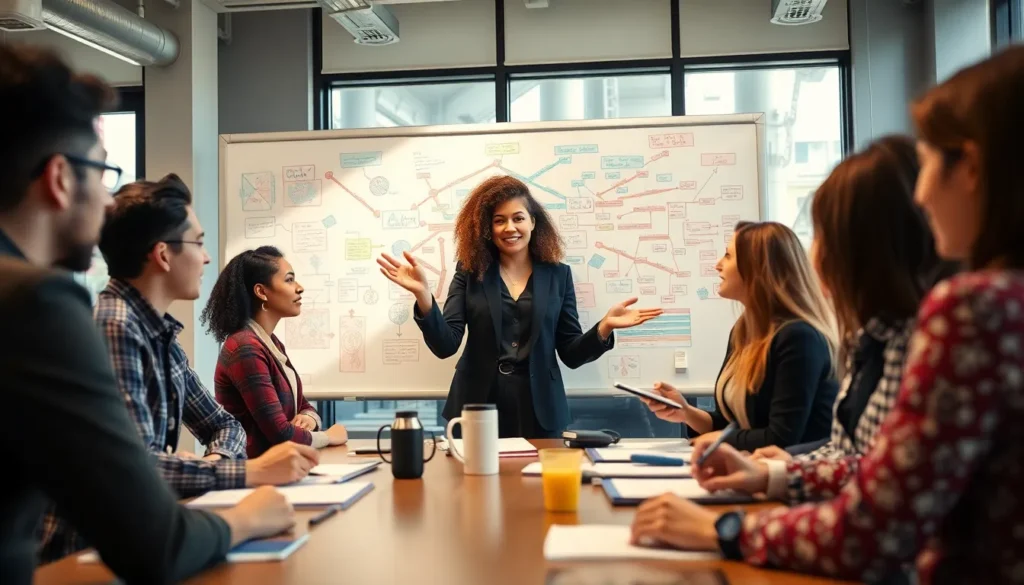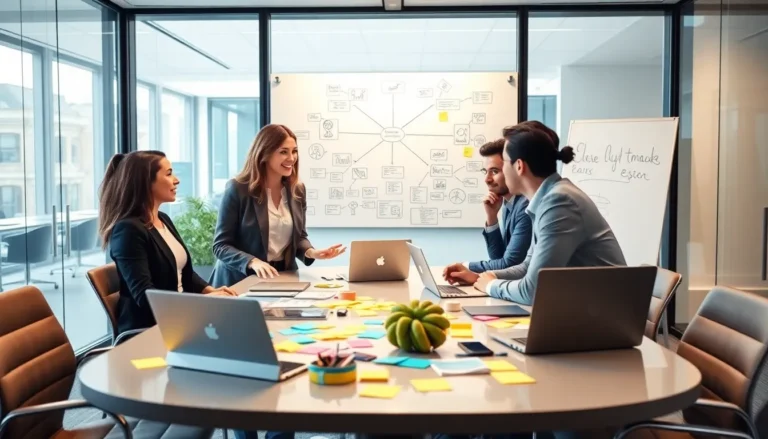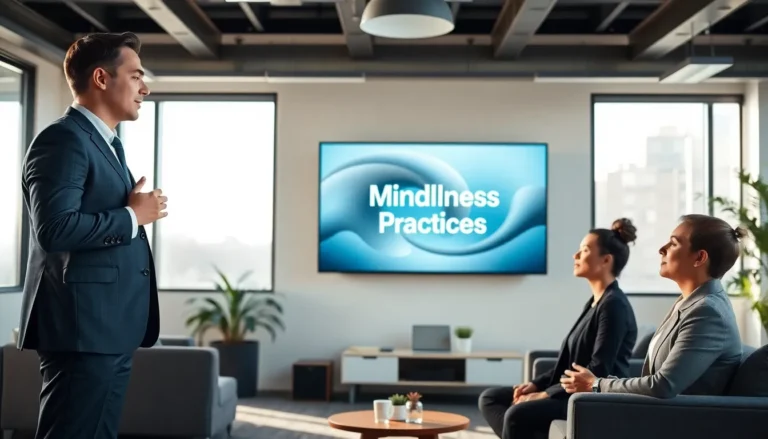Table of Contents
ToggleIn a world overflowing with ideas, standing out can feel like searching for a needle in a haystack—blindfolded. Creative methods are the secret sauce that can turn mundane tasks into extraordinary outcomes. Whether it’s brainstorming like a caffeinated squirrel or using mind maps that look more like abstract art, these techniques breathe life into stale projects and inspire fresh thinking.
Why settle for the ordinary when you can unleash your inner Picasso? Exploring creative methods not only sparks innovation but also makes the process a whole lot more fun. Imagine transforming a boring meeting into a lively brainstorming session that leaves everyone buzzing with excitement. Dive into the realm of creativity, where the only limit is your imagination, and discover how these playful approaches can elevate your work to dazzling new heights.
Overview of Creative Methods
Creative methods serve as effective strategies for enhancing innovation and engagement in various fields. Individuals employ these techniques to break free from traditional thought patterns. Playful approaches like brainstorming involve generating numerous ideas without immediate judgment. Mind mapping visually organizes concepts, fostering connections between ideas.
These methods encourage collaboration, allowing team members to contribute diverse perspectives. Utilizing group activities, such as role-playing, can stimulate fresh insights and solutions. Engaging in activities that stimulate the imagination, like drawing or storytelling, leads to a deeper exploration of ideas.
Incorporating constraints can also spark creativity. Setting limits on time or resources often results in more innovative solutions. Experimentation, through prototyping or trial-and-error, paves the way for unexpected breakthroughs.
Applying creative methods consistently helps individuals and teams develop a culture of innovation. Organizations often experience enhanced problem-solving capabilities when they embrace various techniques. Each method contributes uniquely to the creative process, enabling exploration of new possibilities.
Diverse environments encourage the use of creative strategies. Open office spaces or creative labs inspire collaboration and idea sharing. Regular workshops or brainstorming sessions cultivate a habit of thinking outside the box.
Implementing these creative methods not only improves productivity but also makes the workplace more enjoyable. Organizations can transform their approach by incorporating these techniques into daily operations, leading to extraordinary results. The journey through creativity showcases the potential for innovative outcomes in any endeavor.
Types of Creative Methods

Creative methods encompass various approaches that foster innovation and collaboration. Each method offers unique advantages in generating ideas and problem-solving.
Brainstorming Techniques
Brainstorming techniques involve generating ideas in a group setting. Participants share thoughts without judgment, promoting open communication. Techniques like rapid ideation encourage quick thinking, while round-robin brainstorming ensures equal contribution from all members. Structured brainstorming sessions, such as using prompts or themes, can focus discussions and yield more targeted outcomes. This method fosters a sense of teamwork and encourages diverse viewpoints, leading to a richer pool of ideas.
Mind Mapping
Mind mapping serves as a visual tool for organizing thoughts and concepts. Individuals start with a central idea, branching out to related subtopics. This technique enhances clarity and creativity by illustrating connections between ideas. Using colors and images can stimulate further creativity and engagement. Mind maps encourage exploration and allow participants to see the relationships among different elements, making them an effective method for both individual and group brainstorming sessions.
Role-Playing
Role-playing enables participants to step into different perspectives to solve problems. By acting out scenarios, individuals can better understand the motivations and challenges faced by others. This technique promotes empathy and encourages innovative thinking through experiential learning. Groups can simulate customer interactions or team dynamics, yielding insights that traditional discussions might overlook. Practicing role-playing in diverse situations helps develop critical thinking skills while fostering a collaborative environment.
Benefits of Using Creative Methods
Creative methods significantly enhance various aspects of work and collaboration. These techniques lead to improved outcomes, helping individuals and teams achieve extraordinary results.
Enhanced Problem-Solving
Creative methods foster innovative solutions to complex challenges. Techniques like brainstorming and mind mapping encourage participants to explore diverse perspectives. Individuals break free from conventional thought patterns, allowing for unique insights to surface. A collaborative environment promotes the exchange of ideas, leading to a richer pool of solutions. When constraints are applied, such as time limits, creativity often flourishes. Experimentation through prototyping introduces unexpected breakthroughs, driving effective problem resolution. Engaging in role-playing can also help teams approach problems from different angles, enhancing empathy among participants. Organizations that prioritize these methods often notice enhanced problem-solving capabilities.
Increased Engagement
Using creative methods boosts engagement across projects and teams. Techniques like storytelling and artistic activities invite participants to immerse themselves in the creative process. Visual tools, such as mind maps, clarify ideas and promote active participation. Members involved in interactive sessions often feel more connected to their tasks and colleagues. Incorporating playful approaches during meetings leads to a more vibrant atmosphere, fostering enthusiasm. When individuals actively contribute to brainstorming sessions, they commit more to their roles. Surprising connections made through creative exploration engage participants on multiple levels. This heightened engagement directly improves overall collaboration and productivity in any setting.
Applications of Creative Methods
Creative methods find extensive applications across various fields, enhancing engagement and innovation.
In Education
Educators leverage creative methods to foster student engagement. Techniques like brainstorming and mind mapping encourage students to participate actively in discussions. Role-playing allows learners to step into different perspectives, promoting empathy and deeper understanding of complex topics. Incorporating visual aids and storytelling enriches lesson plans, making complex concepts more accessible. Such methods create a stimulating learning environment that nurtures critical thinking skills and enhances retention of information.
In Business
Businesses utilize creative methods to drive innovation and teamwork. Techniques such as rapid ideation sessions unleash ideas quickly, helping teams address challenges effectively. Engaging in collaborative activities fosters a sense of shared purpose and boosts morale among employees. Visual tools, like mind mapping, clarify project goals and streamline communication. Organizations that embrace these creative approaches cultivate a culture of continuous improvement, leading to enhanced problem-solving and better overall performance.
Challenges in Implementing Creative Methods
Implementing creative methods presents various challenges that can impact their effectiveness. Resistance to change often arises in teams accustomed to traditional approaches, making it difficult to introduce new techniques. Fear of failure can stifle participation, as individuals may hesitate to share unconventional ideas due to concerns about criticism.
Time constraints frequently hinder the adoption of creative methods. Teams may prioritize immediate responsibilities over innovative practices, viewing them as less urgent. Developing a culture that values creativity requires consistent effort, potentially overwhelming those focused on achieving short-term goals.
Resource limitations also play a critical role in implementing creative strategies. Organizations may lack proper tools for brainstorming sessions or visual mapping, which can diminish the potential impact of these creative techniques. Training staff in these methods often needs to be prioritized, with some team members needing guidance to understand how to utilize them effectively.
Awareness of the importance of diverse perspectives is crucial but often overlooked. Team members might prioritize familiarity, leading to homogeneous idea generation that stifles creativity. Encouraging an inclusive environment where all voices are heard fosters innovative outcomes.
Additionally, managing group dynamics presents challenges when employing collaborative methods. Conflicts may arise during group activities, impeding the creative process. Facilitating discussions and ensuring equal participation can mitigate these issues, yet it requires adept leadership.
Ultimately, overcoming these challenges helps organizations unlock the full potential of creative methods, paving the way for enhanced innovation and improved outcomes.
Embracing creative methods can significantly elevate both individual and team performance. By fostering innovation and encouraging collaboration these techniques transform ordinary tasks into extraordinary achievements. They not only enhance engagement but also cultivate a dynamic environment where diverse ideas thrive.
Organizations that successfully implement these methods unlock a wealth of potential and creativity. This leads to improved problem-solving capabilities and a culture of continuous improvement. As teams navigate challenges with open minds and playful approaches they pave the way for groundbreaking solutions. Adopting creative methods is essential for anyone looking to make a lasting impact in their field.




